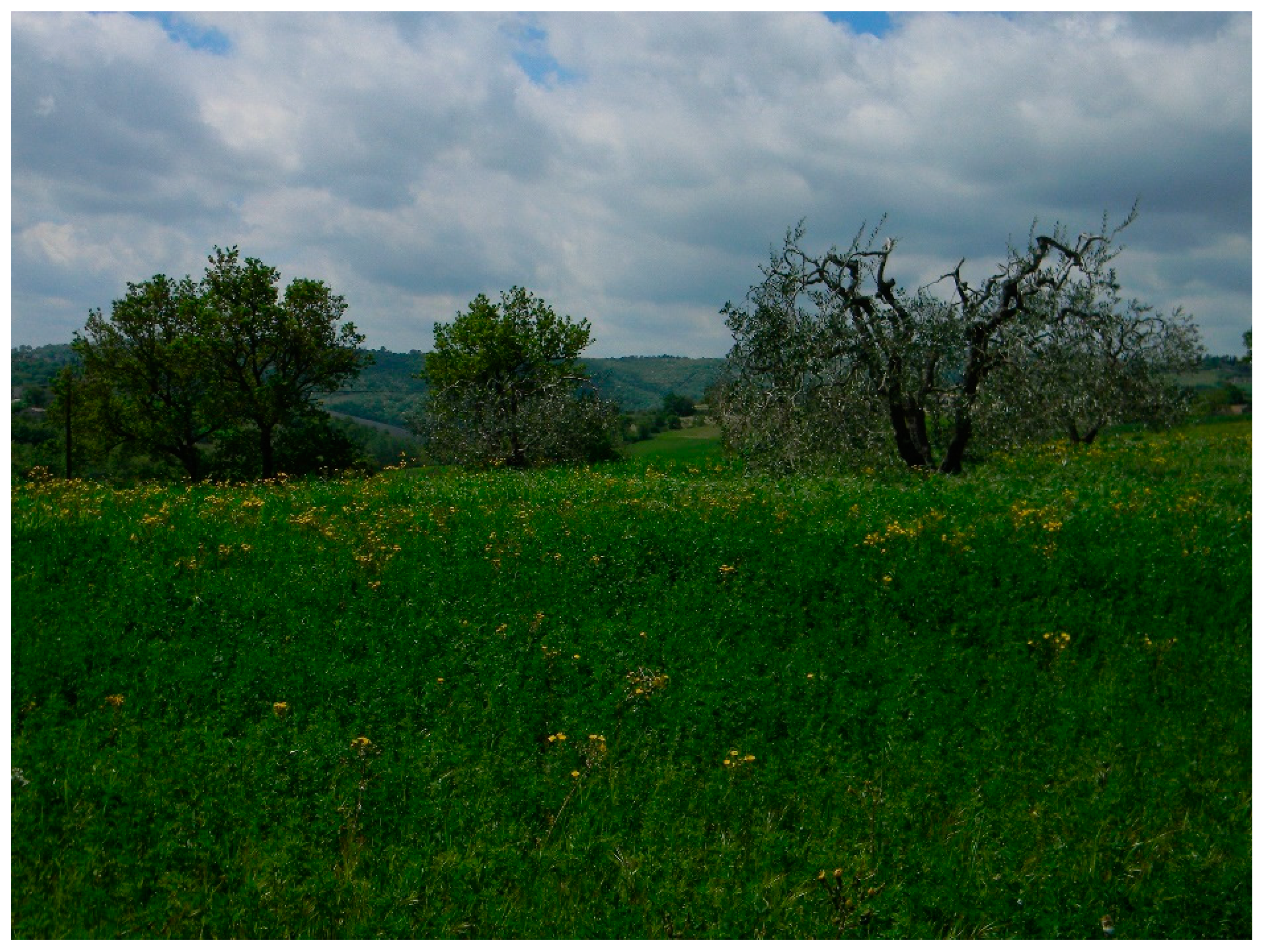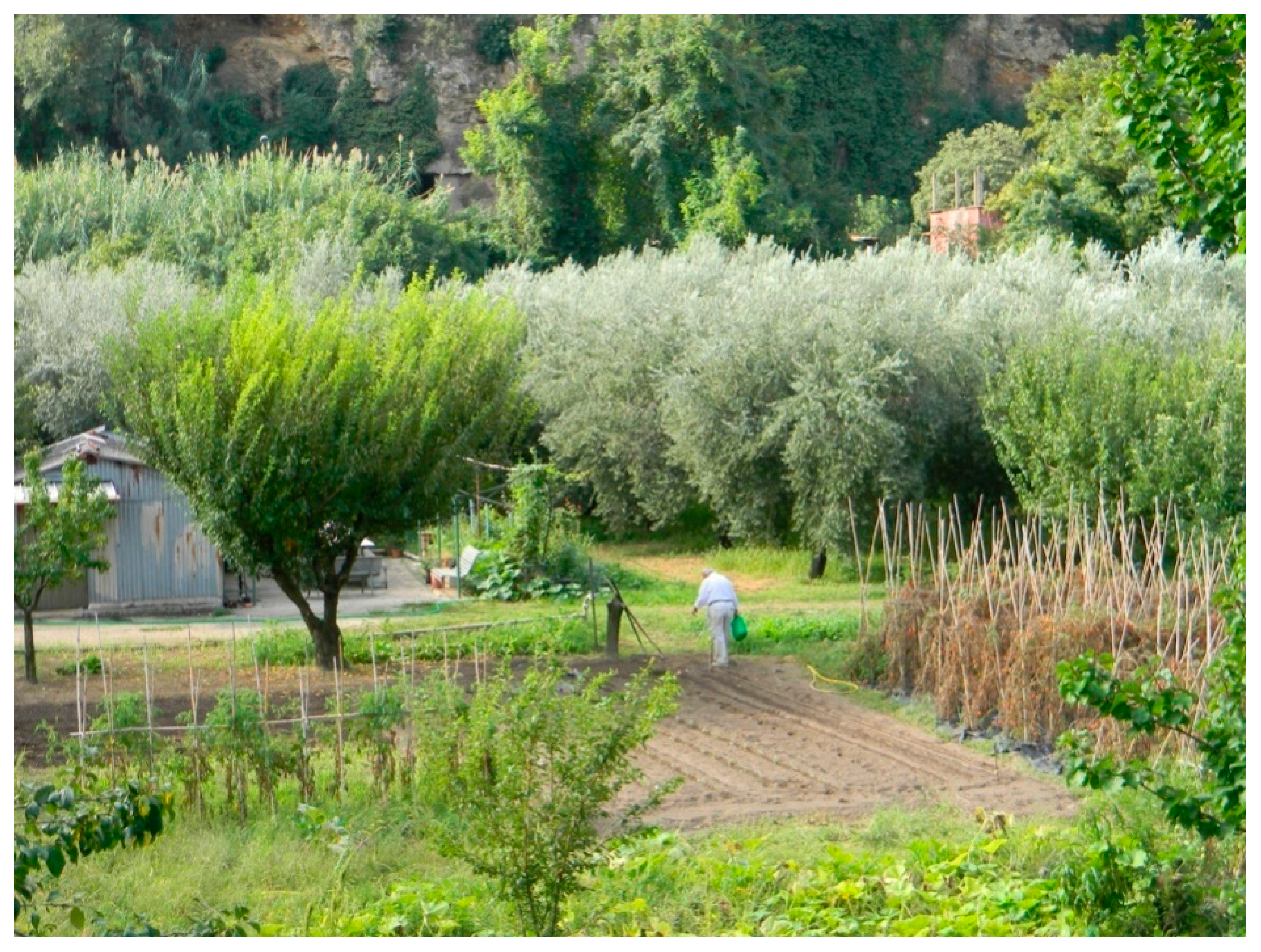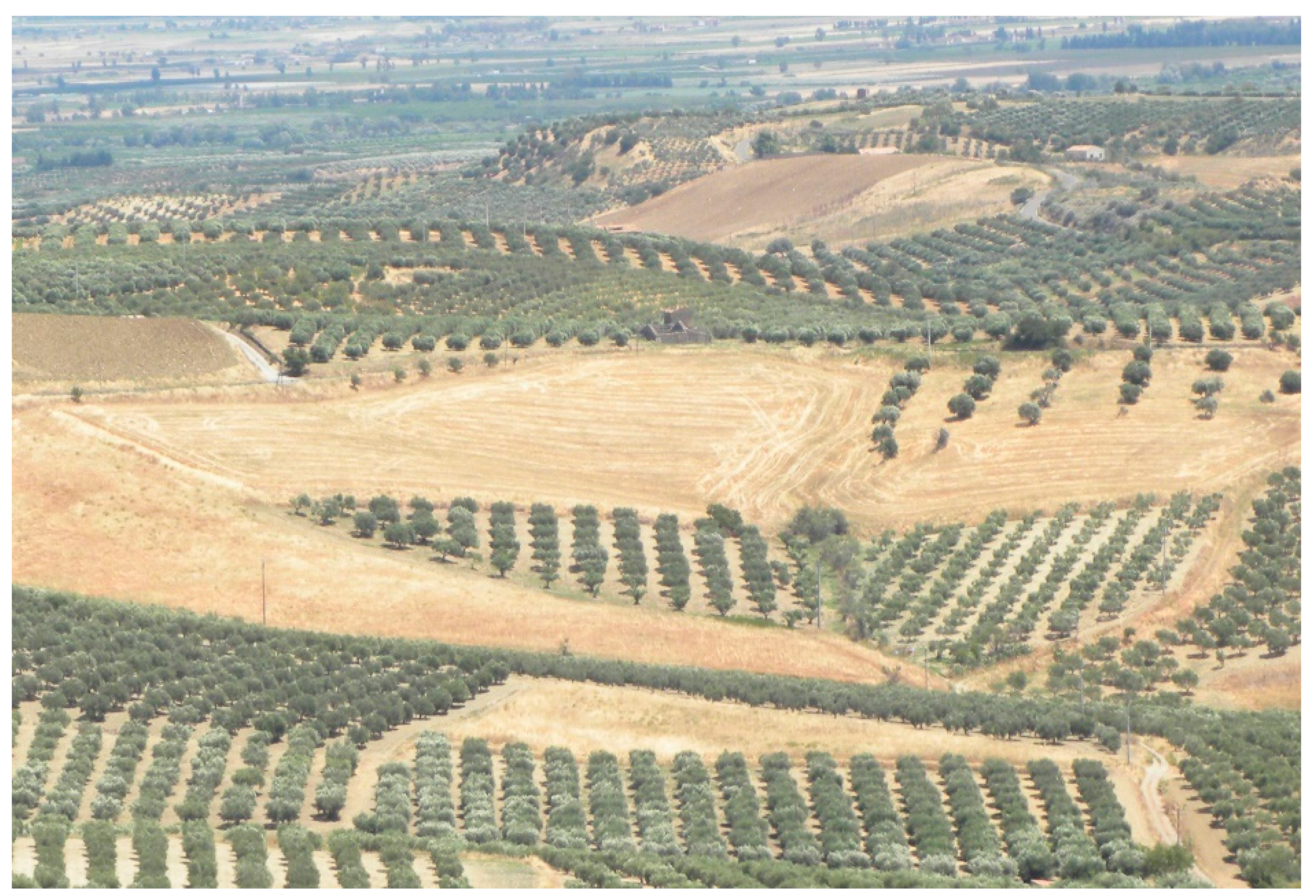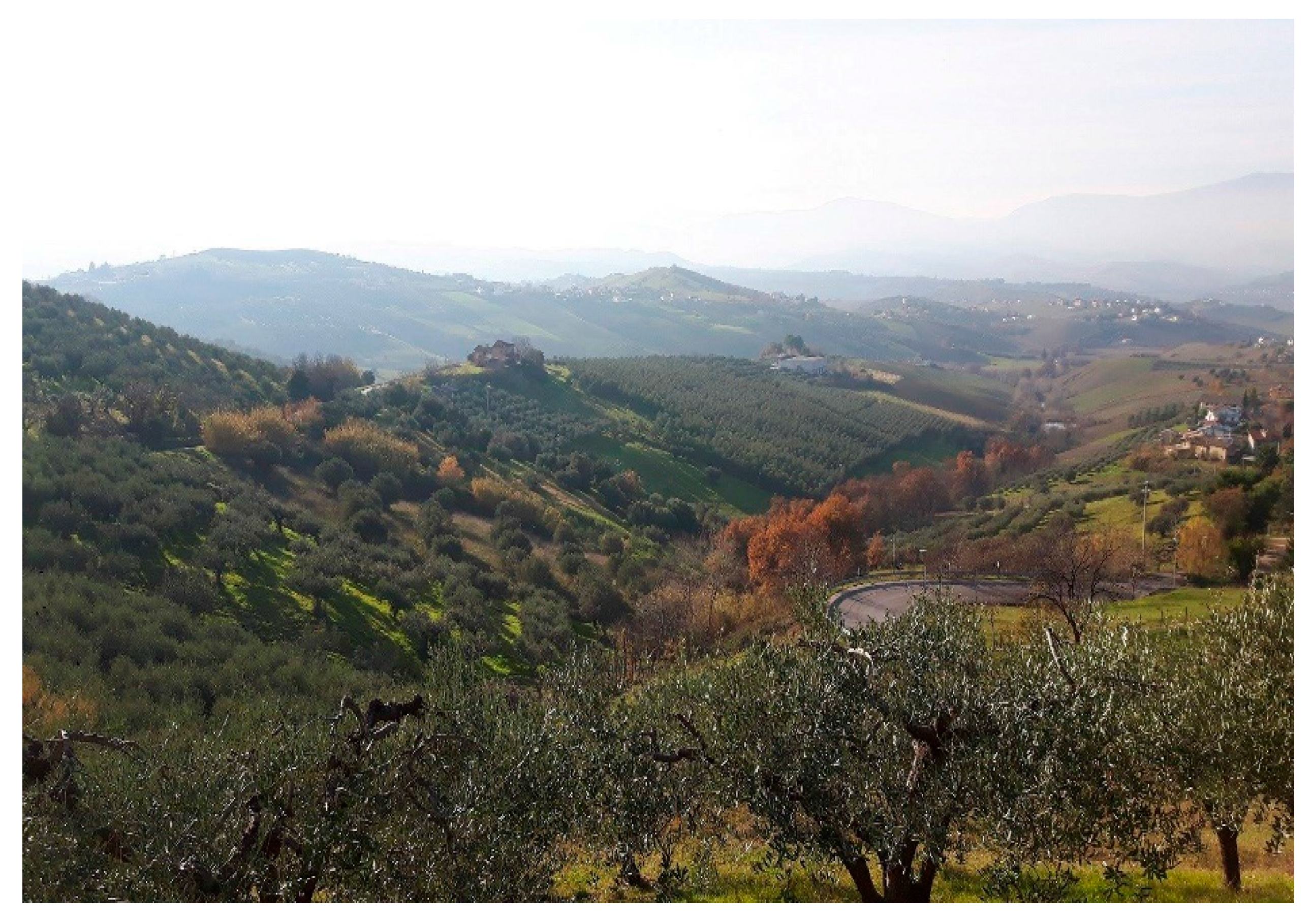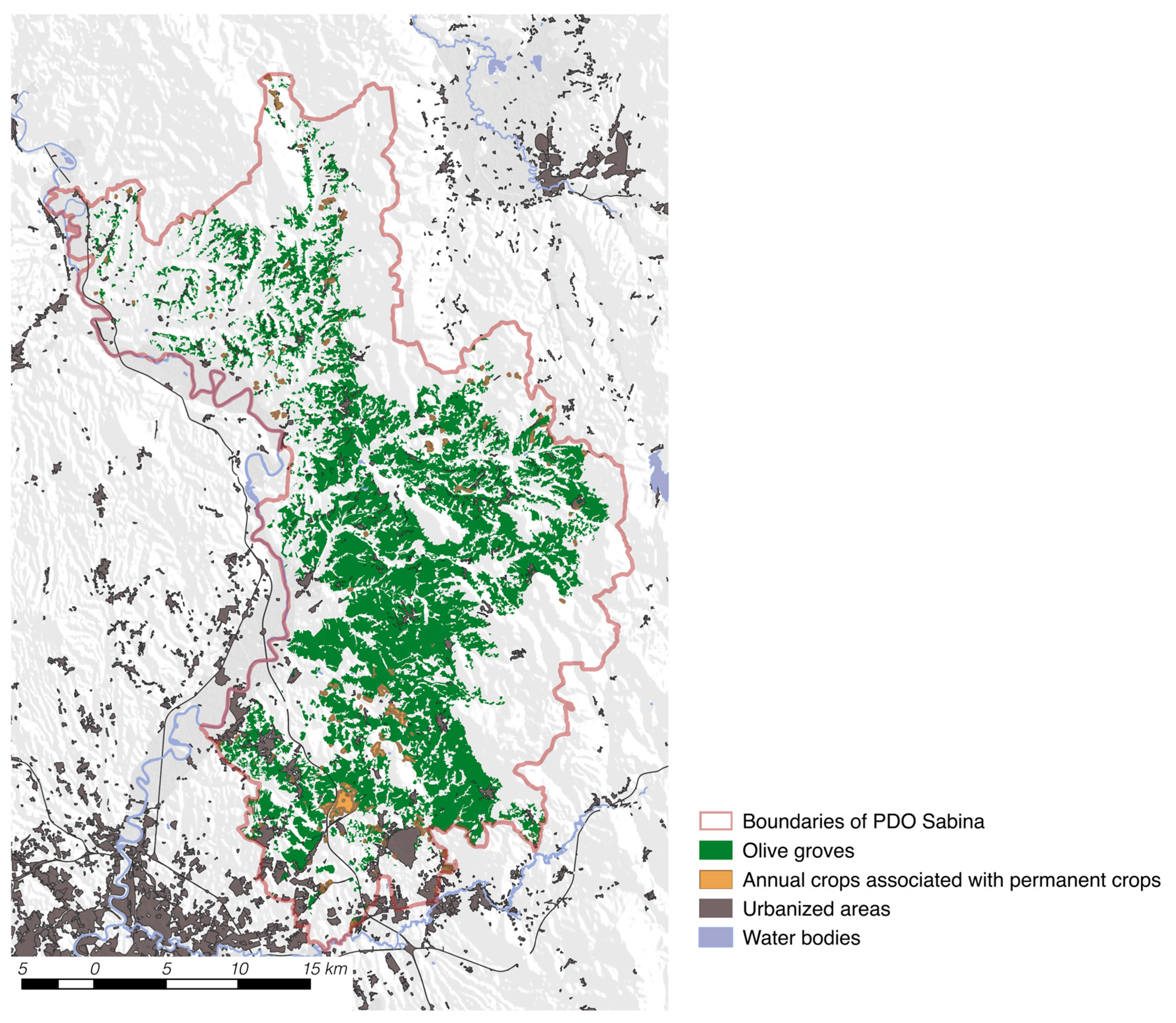3.1. Stories. Putting Down Roots
Olive growing widely developed in Italy between the Fourth and Third Centuries BC, gradually extending from the southern areas to the North, especially in hilly areas where the climate and soil were more favorable to its development [
15].
In the early Middle Ages, monastic orders (the Benedictines) settled in central Italy and shaped huge estates, trying different species and improving yields [
16].
Protectionist measures adopted by Rome encouraged farming and processing practices, which are testified by the spread of the
trapetum, the olive press [
17].
In the Latin world, the olive tree and olive growing are frequently mentioned by agronomists, poets and writers. In his
Naturalis Historia, Pliny the Elder includes the
regia di Sabina (Lazio) among the 14 varieties of olives grown in Italy; Virgilio mentions the presence of the olive in the
Marsica (Abruzzo), while Ovid discusses the production of olive oil in
Valle Peligna (Abruzzo) confirming the practice as well-established [
18].
From the fourth century AD onwards, olive cultivation began to decline. The Empire, with the extension of its operational, political and economic boundaries, was compelled to buy oil for its own consumption from the regions of the eastern Mediterranean and from Greece [
19,
20]. The subsequent domination of the Arabs in the southern part of the Peninsula encouraged the cultivation of fruit trees, especially citrus fruits, hindering that of grapes (for religious reasons) and olives so as to protect the considerable production of oil from their areas of origin.
Renewal and revitalization of agriculture were made possible thanks to the work of the Benedictine and Cistercian monks, who oversaw land earmarked for new trials, planting the main groves: a solid olive farming activity enhanced by varietal selection took place in the hilly areas, with extensive land reclamation and strengthening of slopes [
21].
Political stability prolonged the cultivating momentum of the first Millennium and promoted agriculture around the
Castella and
Poggi established in the Middle Ages. These were all one with their territories of origin, the
contadi, and boasted concentric olive groves of mixed cultivations between the first strip of vegetables and vines and the arable fields further from inhabited areas. The
contado (from the Latin
comitatus, that is ‘county’, the land entrusted to the administration of a
comes, a count) was the area over which the Medieval city wielded its power. Here, the land features were terraces (
terrazzamenti) and embankments (
ciglionamenti), shelves respectively supported by dry-stone walls or embankments of earth, which also extended over time to the hills some distance from the cities with the new demand for ‘land’ to grow crops on [
22].
These patterns have long been preserved: for Italy’s peninsular areas, the
Charter of land use (1960) shows persisting land uses around historical hill settlements, where polycultures once dominated (
Figure 3), and vineyards and olive groves used to be grown together (‘married’ vines). Besides playing a stabilizing role against landslides in steep terrains, such practice allowed vines to lean permanently against the olive trees acting as living stakes.
Crop expansion came to a halt around the end of the sixteenth century due to a prolonged period of cooling (Little Ice Age), after which landscapes were radically transformed: on the coast, olive trees replaced the citrus groves, while at a higher altitude (500–600 m) they underwent significant reductions in favor of almond and apple trees [
23]. Severe frosts in the eighteenth century (after the ruinous and generalized ones of 1709, 1740, 1789 and 1798), along with the negligence of the landowners, caused a massive impoverishment of rural living conditions. In the replanting process, from mid-Eighteen to mid-nineteenth century, a major role was played by institutional initiatives with long-term results and widespread benefits, notably the regulations enacted by pre-Unitarian States such as the Papal States—for Lazio, Umbria, Marches and part of Emilia-Romagna—and the Kingdom of Naples—for Abruzzo and Molise, Campania, Calabria, Basilicata and Puglia.
In the first phase—restoration and expansion—olive growing was confirmed as an ‘accompanying’ cultivation providing extra income. In marginal foothill areas or higher slopes most difficult to maintain, olives also performed the task of holding the soil in place on the inclines and combating landslides. Where the gradient allowed it, the land was used for sowing crops, and olive trees could also perform the task of supporting the rows of vines.
In this epoch of recolonization and dissemination of the olive, the public sector supported interventions with incentives and reforms reshaping land ownership and helping establish crop variation within significant portions of territories [
24]. Geographies were specified and rural landscapes redesigned; these were very diverse, not only for the multiplicity of the areas concerned (morphologies and latitudes), but also for the variety of approaches and density of planting.
As an example, with reference to the
Department of the Tiber, which included during the years of French occupation (1809–1814), a large region around Rome with the greatest olive growing areas in Lazio, the Prefect De Tournon distinguished between high production areas and average production areas [
25]. In the former, particularly in the Tivoli arrondissement, the average yield of a plant was as much as 6 to 10 deciliters per year, and the cultivation of olive trees assumed the character of specialized olive grove in those rare cases of a density of 150 plants or more per hectare. Other patterns were to be found in terraced areas, with trees growing within 5 feet from each other (in the municipalities of Velletri, in the vineyards of the municipalities called ‘the Castelli’ south-east of Rome). Irregular patterns, termed ‘scattered’, are mentioned as well.
De Tournon reports that, in 1813, in Lazio alone, olive farming covered some 27,000 hectares, producing three million liters of oil. To the north of Rome, the Sabina, ‘open only to the winds of the South’, boasted model productions, thanks to the trials carried out by an enlightened group of landowners: in Tarano (Marquis Potenziani), Castel Nuovo di Farfa (Marquis Simonetti), Piediluco (Marquis Pianciani), and Monteleone (Baron Gambari) [
26].
The Papal States wavered between hankering after the free market following the drive for modernization promoted by the European Nation States and protectionism fundamentally aimed at ensuring distribution and trade on major urban markets of basic necessities: wheat, oil and meat. These food items were marked with the term ‘grascia’ (from Latin
crassia, fats). In the case of Rome, a city with no countryside due to land organization still based on large unproductive estates, the fundamental issue was catering for the needs of a population of about 200,000 inhabitants with goods coming at great expense even from distant countries by mainland and sea. Alongside the rules on the preservation of the slopes with reforestation measures, from the mid-eighteenth century onwards, the Papal State encouraged the planting of olives for productive purposes, setting up the incentive of 1 Paolo (the tenth part of the Papal Scudo) per tree, equal to the daily wage of a farm-worker [
27].
Whilst, at the turn of the century, domestic demand was very far from being met, in the mid-1850s in the traditional areas of production—the Frosinone region, the Tiber basin, Umbria and
Tuscia, but also in the papal
Marca—there were over 95,000 hectares planted with olives and 1500 hectares with vines and olive trees: a sizeable production meeting 87% of domestic requirements [
28].
In the Papal Provinces of Marche and Umbria, a particular form of contract, sharecropping, began to take hold, resulting in mosaic landscape patterns due to a more or less intensive polyculture with wood crops on flat lands and slopes, often alternating with woods and pastures, which tended to shrink, and small tenures of size on average less than ten hectares.
In the Kingdom of Naples, the sale of State property from 1806 onwards gave origin to the division of agricultural land and the transfer of ownership. Oil production resumed with two kinds of arrangements, the so-called
contratti di livello and the
enfiteusi (leases) [
29], and there was general improvement of country life conditions.
The second phase—
raising the altitude of groves and supporting the mountain economy—took off a few years after the Unification of Italy (1861). In this period, landscape transformations were characterized by drastic reduction of the forests, even at the expense of the integrity of the soil and slope stability, and by increased tree crops which, in the South and in the
Agro Romano, integrated the field system and the transhumance of sheep flocks [
30].
The more favorable climatic conditions fostered a process of ‘taming’ of the mountain, in which the traditional economy of the forests and sheep-rearing were integrated with the cultivation of land leased according to ‘rights of commons’ consisting of collective rights, such as hunting, grazing, planting, rooted in practice only by the members of a particular community. This process underwent a substantial acceleration with the Forest Law of 20 June 1877, which allowed the cutting of wooded areas to the upper limit of the chestnut trees—an altitude of 1200 m, 1000 on the Adriatic side and 1300 to 1400 m in the inland areas—and substitution with fruit-bearing trees.
The olive tree, grown in mixed form, spread up to an altitude of 800 m in the valley areas between mountains exposed to the East and sheltered from the winds, especially on the Majella and Gran Sasso mountains (Abruzzo). Superficial and expanded roots (60–100 cm depth) are adapted to stony ground and hold the soil on the slopes, while the natural robustness of the trees allows them to resist in temperatures of −5 °C; finally, the dry climate protects the fruits from the many parasites.
In the South (mainly the areas which used to belong to the Kingdom of Naples), between 1860 and 1929, the basic stability of areas of arable land with or without trees and permanent pasture and meadow was matched by a considerable increase in areas with trees and specialized crops (from 276 to 1609 thousand hectares) and the halving of the areas with woodland and chestnuts (from 2094 to 1277 thousand hectares) (
Figure 4).
The gradual transformation of arable land into olive groves changed conditions throughout central Italy, providing an important contribution to income from agricultural work, and shaped new landscapes between the woods and villages, thus setting off a process of differentiation in the Apennine areas.
However, in Abruzzo, the production of olive oil, which represented 6.4% of the national total ten years from the Unification of Italy, underwent a continual reduction until the end of the 1930s (4.9%), regaining momentum in the post-War period (at the end of the 1950s it was almost 6%). Nevertheless, the areas devoted to olive growing almost tripled from 1870 to 1951 (from 68 to about 200 thousand hectares), still prevailing as polycultures over specialized crops in a ratio of 20 to 1 [
31].
3.2. Geographies, Economies and Consolidated Landscapes
Until the 1960s, olive trees were considered natural tree species not needing specific treatments (fertilization and pruning), in the absence of which profitability was very low. After the destruction caused by the frost of 1956, there was widespread replanting (specialized) and new agricultural contracts supported by government grants (Law 839 of 26 July 1956, refinanced several times) to the peasants-farmers aimed at covering the costs of replanting, treatment and pruning.
The law also financed specialization courses in olive growing and olive oil extraction and provided funds for district agriculture authorities and observatory stations of plant diseases and insect pests devoted to technical assistance to farmers. This was in accordance with customary regional and local practice: in fact, since the Unification, a major effort was made in order to diffuse economic practices and techniques in specific schools of agriculture or delivered by municipal ‘peripatetic chairs’ that changed location every few years.
Both Lazio and Abruzzo, albeit with very diverse territorial and historical situations, have accumulated precious experience in cultivation and oil production (
Table 1).
The last few years have been particularly difficult everywhere in the Italian Peninsula, following a fall in production and problems with pests and diseases, as well as the restructuring processes of the production base that sacrificed the smallest firms, which did not join associations. In fact, in 2010, the olive sector numbered 902,075 firms, a decrease of 19% compared to 2000, and registered 1,123,330 hectares of utilized agricultural area (UAA), a rise of 5.3% [
32,
33].
Due to the rationale of the agricultural sector, these economies take on locally diverse characters. Still, whatever the home place, contemporary lifestyles are shaped by urban needs, often involving daily commuting between the work-place and urban facilities. Production in Lazio satisfies the demand of the extensive market of the Capital, whilst that of Abruzzo serves a less populous area within a more widespread distribution of cultivation.
In Lazio, with a national share of 4%, olive cultivation is a widespread traditional activity: according to the Census of 2010, there were 67,996 firms involved (70% of the total), over an area of 67,438 hectares.
Since 2000, the regional olive sector has seen a progressive reduction in the number of firms devoted to producing table olives and olive oil and a concomitant, albeit more modest, reduction of cultivated areas. The two trends have resulted in a moderate increase in average farm size, which stands at one hectare.
Olive production in specialized facilities is conducted by 32,859 firms with an acreage of 35,463 hectares, corresponding roughly to one-half of all olive producers (48.3%) and holding 52.6% of the regional olive growing area.
One-quarter of the estimated production of olive oil is being marketed without intermediaries and in traditional ways: proximity to the olive press or personal acquaintance with the manufacturer. In both cases, product certification is not requested by consumers, who base their choice on direct experience of the production site and on product reliability.
Small-scale production for own consumption is frequent, but hard to quantify. Associating for marketing (5.9% of the estimated production of olive oil, 3.2% of growers) is rare compared to wine, cereals, fruit and vegetables and dairy products, revealing resistance to novelty that can only further affect a sector already in difficulty.
Abruzzo is the fifth region in Italy for production, with a national share of 2.8%, although in recent years this has declined by about 35%. Weather conditions and in particular persistent droughts have greatly impacted on fruiting, causing wilting of drupes where no additional emergency irrigation was provided.
Nevertheless, Abruzzo boasts an important olive growing tradition distributed evenly over much of the region, with over 54,273 firms, of which only one-quarter display specialty crops—and an area of 39,873 hectares with more than 9 million and about 40 varieties of trees, for the most part organically grown.
Marketing is primarily through direct sale by the producer or processor/press owner. From data processed by INEA, 18% of total production is for own consumption; of the remainder, 58% is sold by the processor/press owner, 27% through direct sales by the company, 10% through the commercial network, whilst 3% is for catering firms and 2% goes to the food industry [
34].
In Abruzzo, olive cultivation is widely and comprehensively distributed throughout and, along with viticulture, stands for the category ‘permanent crops’. The coastal hills (above sea level to 200 m) are characterized by a better overall terrain, often irrigated and irrigable, by mostly specialized plots bearing not very old plants, yet with productivity greatly affected by weather conditions and the presence of the olive fruit fly.
The internal hilly area (between 200 and 350 m above sea level) is where most olive orchards are to be found. Olive cultivation here is closely linked to the landscape, culture and traditions; in these areas, there are medium to small family farms, but also numerous orchards of greater size. Olive trees on average are older than 50 years and there are numerous examples of ancient, centuries-old olive groves where high qualitative and quantitative levels are reached. Olive groves in the hilly foothill areas and inland areas (between 350 and 700 m above sea-level) are less important, although there are age-old plants and olive groves of considerable extension. There is good potential here: the oil produced is of good quality and trees show good resistance to pest attacks.
A number of Protected Designation of Origin Production areas (PDO areas) include or are close to the cities: this proximity between rural and peri-urban gives rise to landscape mosaics characterized by high fragmentation in land use, including arable land evoking the old practice of mixed cultivations. At the same time, as previously argued, these areas are rooted in a crop tradition dating back to Benedictine settlements and somehow reshaped according to the post-War ‘territorialization phase’—
replanting and specialization—which set off all over the Peninsula a process of replacement of polycultures with specialized ones (
Table 2,
Figure 5).
Such connection between olive cultivation, hilly landscape and oil is at a turning point whose evolution is difficult to interpret. It concerns both the production sector in the strict sense—economies and income—and the chance to keep reading the forms of landscape devoted to olive farming according to the established syntax of rural areas.
Interviews with professionals, experts and farmers, urged to provide insights into production, processing and marketing of olive oil on the domestic and international markets, provided further considerations over strengths and weaknesses of the sector with a major focus to place-specific development paths, that is ‘territoriality’.
Besides sector-specific barriers to market, olive production areas are confronted with the need of more sustainable and resilient scenarios. The olive oil sector displays several strengths, such as strong territorial characterization; fairly good specialization and steady-state quality levels; willingness to invest on quality; proximity to urban market; inherent resilience of olive groves despite the labor crisis; excellent product personality; availability of first class olive pressing plants in the vicinity; consortiums’ proactivity in the marketplace; and, in the case of PDO Sabina, some success of standardized packaging in order to bestow identity to the brand.
Among the weaknesses, on the backdrop of seasonal fluctuations in product quality and yields emphasized by climate change, inherent criticalities are small-size farming; ageing and poor generational change; inadequate overall awareness of the product compared with other production areas in Italy; strong competition from imitation products; drop in the price of olive oil in the market place with speculative behaviors of brokers and traders delivering last stocks below market price; a general trend to standardize the manufacturing process at the expense of strong territorial characterization. Most often, skilled labor in harvesting and pruning is lacking or is very expensive, and the trees undergo severe deterioration (
Table 3).
The need to stabilize olive oil production by limiting its fluctuations requires rationalizing or expanding specialty crops in the medium hill strips (300–500 m), or otherwise searching for new locations: such is the case of the Roveto valley along the Liri River (Abruzzo), where over the last six years 5000 olive trees have been replacing the forest along the lower hillsides.
New opportunities derive from emerging domestic and foreign markets, even due to an increase in extra virgin olive oil consumption following healthy nutrition models and guidelines (Mediterranean diet).
As for threats, both the Common Agriculture Policy and the reduction of duties for products from southern Mediterranean countries expose olive oil to unfair competition, even more so with the aftermath of the 2008 crisis. The abandonment of the plants in the inner areas results in irreversible deterioration of the environment and rural landscape. Such phenomena increase the divide between subsistence agriculture in so-called ‘bone land’, that is interior areas and rugged territories historically affected by water scarcity, and the well-irrigated and productive zones of the ‘pulp land’ [
35].
The olive oil sector does not require a clear separation between the different stages of the supply chain. It is therefore not necessary to distinguish between primary processing—activities linked to the presses—and the second stage—bottling and marketing. While many medium-sized and small companies are vertically integrated, large companies have specialized industrial enterprises in the true sense of the word: they buy oil, possibly blend and bottle it, usually far from the places of production, and then market it.
The stages may be very varied and depend on the company size, people involved and market dynamics. Most customers buy direct from the producers, whilst access to new technologies enables consortia to reach far away markets worldwide. In both cases, networking plays an important role. However, direct purchase is tending to shrink, and online purchasing concerns just a niche market. Conversely, the big industries needing critical mass and a more standardized product in terms of quality, organize their production according to the organoleptic characteristics of the oil rather than to its origin. Such unfair competition relying on lower costs and easier access to urban markets through large retailers, marginalizes, by so doing, the share of daily use of this quality product.
All considered, contemporary olive economies and landscapes are increasingly differentiating from the traditional ones: olive growing modelled the territories where it was introduced, updated modes and cultivation techniques, and set off the process of modernization of the whole chain: producing, processing and marketing [
36]. Still, for the olives here, as elsewhere for grape growing, small ownerships, often neighboring specialized farming, find it hard to associate due to deep-rooted mindsets (
Figure 6 and
Figure 7). Yet, we do not know how they will evolve, nor for how long [
37].
In the case of PDO production area Aprutino-Pescarese, the leading agricultural cooperative established in 1966 consists of about 11,000 members, with an oil production of almost one-fifth of the regional total. It guarantees the quality of the processed product and marketing in foreign markets for a share of 70% of the regional total.
As for PDO production area
Sabina, the past programming period 2007–2013 has witnessed the establishment of the Leader + Community initiative Program ‘GAL Sabina’, intended to increase quality and profitability as well, facing highly fragmented ownership, general ageing and a certain amateurism in cultivation practices. Conversely, the huge catchment area of Rome would allow for a short food supply chain market strategy [
38,
39]. Current Rural Development Plan (RDP) 2014–2020 contemplates public commitment to supporting multifunctional production and market-oriented strategies while promoting sustainable rural development processes by providing basic services such as certification, presses, transparency in international trade, etc.
The purchase and ‘reparcelling’ of small ownership is a key element in order to improve competitiveness both in terms of cost containment and of easier access to distribution channels usually requiring a minimum level of production; for such purpose, the analyses conducted indicate that regional policies could facilitate and increase corporate restructuring [
40].
3.3. Ongoing Processes and Possible Scenarios
As previously discussed, most enduring landscape features in central Italy are associated to olive growing in specialty crops or intertwined with other crops. Still, the data set at the national level shows how both patterns have changed over half a century (
Table 4).
Overall, the cultivations decreased by half, mainly at the expense of promiscuous crops that account for less than 1/10 of the surfaces occupied in 1960. Currently, 90% of the total olive growing land use is attributable to specialty crops.
Surveys conducted nationwide on 2010 Census data account for strong correlation between olive growing and steep land areas. No less than 61% of olive crops are still located in hilly areas, 11% in the mountains and 28% in lowlands (Census of Agriculture 2010). High fragmentation is a main feature: firms under the threshold of 5 hectares account for 80% of the total amount. The majority of these micro-enterprises are, in fact, the result of extreme hereditary divisions, or of subdivisions of agricultural plots for new land uses, notably in the urban fringe, that can be either more or less cultivated or abandoned, due to the inability or unwillingness to continue their maintenance [
41].
Thematic mapping can only detect ‘olive groves’, that is “are as planted with olive trees, including mixed occurrence of olive trees and vines on the same parcel”, as a single land cover category corresponding to extremely varied landscape patterns within the comprehensive land use class ‘permanent crops’. Due to geomorphology, pedology, slope orientation, and the ‘human factor’, no generalization is possible: between a central Italian olive tree and a southern Italian one, there is often the same difference as that between a dwarf and a giant. The olive tree landscapes themselves follow different ‘paces’, according to the cultivars and planting layouts. In the nineteenth century, specialty crops bore some 150–200 samples per hectare. Current arrangements enable olive-growers to accommodate up to 400–460 plants per hectare, creating entirely new landscapes [
42]. Planting distance on average fluctuates, in the vase-shaped trees—the form adopted in most cases—from 7 to 12 m, to avoid the canopies touching once they reach their maximum development: excessive density may irreparably affect the outcome. Finally, a major distinction is to be drawn between so-called square designs, in which the trees are equally spaced within and between rows, and the equilateral triangle system, where trees are planted at the vertices of equilateral triangles.
Conversely, in hilly inland areas, landscape characters associated to olive economy owe a lot to the millenarian persistence of traditional orchards combined with grassland: from the standpoint of rural economies, the small size of properties still allows for a recurrent pattern displaying olive trees in rows variably arranged.
In this respect, the PDO Sabina production area falls within the borders of the Roman ‘Sabina Regio’, northeast of Rome, touched by the Tiber River and its tributary Aniene River. As shown in
Figure 8, specialty crops, mostly located in hilly areas, are less frequent at higher altitudes, in the river plain and along minor tributaries.
The area encompasses large estates which used to belong to the Benedictine Abbey of Farfa.
Here, small size parcels which may accommodate even residual or newly planted groves (within the category ‘Heterogeneous agricultural areas’, notably ‘Annual crops associated with permanent crops’) remind of sharecropping systems (
Figure 9). Still, due to the size and features of these plots, such a phenomenon is underestimated by thematic mapping.
All these arrangements are more or less dependent on/resilient to the needs from the urban areas requiring the ‘countryside’ for consumption both in terms of products and of leisure time, among a broad range of green spaces and other environmental features. Altogether, the signs of this epochal transformation were already apparent to Henri Desplanques who, in the 1970s, wondered “whether agriculture is actually endangered, and if horticulture and certain forms of leisure agriculture will remain. Rome counts less and less on the Agro Romano and on Lazio, which has a population of less than 10% active in the sector, to obtain foodstuffs” (pp. 751–752).
As a matter of fact, from WWII onwards, a major change in the shares of labor employed—in 1950, no less than 42% of the active Italian population was employed in agriculture, whilst in 2010 only 3.8%—has significantly impacted on lifestyles and settlement structures at the expense of agricultural land [
43]. At present, according to the dictates of productivity fueled by high returns from intensive farming, new ‘operational landscapes’ are at work: they display all the characteristics of industrial exploitations, all the more so because the building industry has long been affected by the crisis.
As a matter of fact, productivity imperatives compel the adoption of new cultivation techniques, and the olive tree is intensively cultivated within the limits of its range of possibilities, even and especially in lowland areas (espalier). Nowadays, much of the mass market is controlled by foreign companies (especially Spanish), which have relieved important Italian quality brand names but are marketing alien productions. To fight foreign competition, large farms all over the country, even in areas of manufacturing excellence, are preparing new intensive approaches according to the model designed and developed by the Nurseries Agromillora Catalan in partnership with the Institut de recerca y tecnologia agroalimentaries of Catalonia.
Such systems contemplate the replacement of local cultivars with others deemed more suitable, with larger fruit and better yields (90–100 quintals per hectare of olives per year), and the use of the espalier system which allows an increased tree density (from 400 trees of the traditional specialized plot to about 1500–2000 trees per hectare) (
Figure 10).
To promote mechanized plot management (pruning, treatments and harvest) and significantly reduce the cost of harvesting, the new plots are located on gentle slopes or preferably flat ground, where irrigation is also easier (
Figure 11).
From an agronomic point of view, there are certain limitations, such as poor durability of the tree which, to maintain productivity, must be replaced every 15–20 years, with a phase of minimum development of 3–4 years with increasing yields. This new practice, although still marginal, indicates some probable developments.
In relation to production, we find a growing separation between the oil’s characteristics and its area of origin, and a further reduction of certified products reserved for niche markets. However, as regards to the renewed ability to create landscapes, we are contributing to a massive relocation of crops from the hillsides to flat ground, while small groves (some no longer producing, having been abandoned) and ‘rural gardens’ will have the task of protecting the environment, as well as holding the soils of the hilly slopes and foothills.
All these phenomena bear witness to the lack of effective actions to oppose any rationale based on profit, and to few territorial policies able to preserve the environmental, cultural and economic development of the rural space. In fact, the destiny of urban areas depends upon effective and resilient agri-forestry strategies and health and food security policies; thus, oil economies and olive landscape, as main components of such ever broader ‘urban domain’, should be at the core of any planning instruments and policies.
